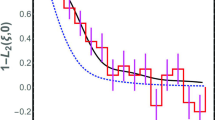Abstract
Interference and diffraction of two-identical-particles are considered in the context of open quantum systems. This theoretical study is carried out within two approaches, the effective time-dependent Hamiltonian due to Caldirola–Kanai (CK) and the Caldeira–Leggett (CL) one where a master equation for the reduced density matrix is used under the presence of dissipation and temperature of the environment. Two simple but very illustrative examples are considered, diffraction by a single and two Gaussian slits by analyzing the mean square separation between particles, single-particle probability density and the simultaneous detection probability or diffraction patterns. Concerning the single Gaussian slit case, in the CK approach, the mean square separation drastically reduces with friction, reaching a constant value due to the localization effect of friction. On the contrary, in the CL approach, temperature has an opposite effect on friction and this quantity increases. Furthermore, there is a time interval for which the joint detection probability is greater for fermions than for bosons. As has already been reported for non-dissipative systems, fermion bunching and boson anti-bunching are also observed. The decoherence process, loss of being indistinguishable, is settled gradually with time by increasing friction and temperature. In the two Gaussian slits problem within the CK approach, the single-particle probability density behaves almost similarly for all kinds of particle pairs displaying small overlapping between one-particle states. The differences among the three statistics decrease when dissipation increases. However, in the opposite limit, fermions behave completely differently from bosons which themselves behave like distinguishable particles. This last behavior is also seen when the interference pattern is considered by computing the detection probability of both particles with two detectors, one fixed and the second mobile.









Similar content being viewed by others
References
G. Baym, Lectures on Quantum Mechanics (W.A. Benjamin, New York, 1969)
R.K. Pathria, Statistical Mechanics (Pergamon Press, New York, 1988)
A.S. Sanz, S. MIret-Artés, J. Chem. Phys 126, 234106 (2007)
M. Berry, I. Marzoli, W. Schleich, Phys. World 14, 39 (2001)
S. Gerlich et al., Nat. Phys. 3, 711 (2007)
B.S. Zao, G. Meijer, W. Schöllkopf, Science 331, 892 (2011)
S. Miret-Artés, E. Pollak, J. Phys. Chem. Lett. 8, 1009 (2017)
G. Rojas-Lorenzo, J. Rubayo-Soneira, S. Miret-Artés, E. Pollak, Phys. Rev. A 98, 063604 (2018)
C.K. Hong, Z.Y. Ou, L. Mandel, Phys. Rev. Lett. 59, 2044 (1987)
S. Bose, D. Home, Phys. Rev. Lett. 88, 050401 (2002)
Y.L. Lim, A. Beige, New J. Phys. 7, 155 (2005)
P. Sancho, Eur. Phys. J. D 68, 34 (2014)
A. Marchewka, E. Granot, Eur. Phys. J. D 68, 243 (2014)
A. Marchewka, Ann. Phys. 355, 348 (2015)
A.S. Sanz, R. Martinez-Casado, H.C. Peñate-Rodriguez, G. Rojas-Lorenzo, S. Miret-Artés, Ann. Phys. 347, 1 (2014)
M.D. Kostin, J. Chem. Phys. 57, 3589 (1972)
S.V. Mousavi, S. Miret-Artés, Ann. Phys. 393, 76 (2018)
S.V. Mousavi, S. Miret-Artés, J. Phys. Commun. 2, 035029 (2018)
S.V. Mousavi, S. Miret-Artés, Eur. Phys. J. Plus 134, 311 (2019)
S.V. Mousavi, S. Miret-Artés, Eur. Phys. J. Plus 134, 431 (2019)
C. Zander, A.R. Plastino, Entropy 20, 473 (2018)
A.O. Caldeira, A.J. Leggett, Phys. A 121, 587 (1983)
A.O. Caldeira, An Introduction to Macroscopic Quantum Phenomena and Quantum Dissipation (Cambridge University Press, Cambridge, 2014)
S.V. Mousavi, S. Miret-Artés. arXiv:1906.08526v1 [quant-ph]
A. Venugopalan, Phys. Rev. A 50, 2742 (1994)
A. Venugopalan, D. Kumar, R. Ghosh, Phys. A 220, 563 (1995)
R.P. Feynman, A.R. Hibbs, Quantum Mechanics and Path Integrals (McGraw-Hill, New York, 1965)
P. Sancho, J. Phys. B At. Mol. Opt. Phys. 43, 065504 (2010)
I.C. Moeeira, Lett. Nuovo Cimento 23, 294 (1978)
Acknowledgements
SVM acknowledges support from the University of Qom and SMA support from the Ministerio de Ciencia, Innovación y Universidades (Spain) under the Project FIS2017-83473-C2-1-P.
Author information
Authors and Affiliations
Corresponding author
Appendix A: Two-particle Schrödinger–Langevin equation
Appendix A: Two-particle Schrödinger–Langevin equation
In this appendix we construct the two-particle Schrödinger–Langevin equation and show that the symmetrization procedure does not work.
Suppose \(\psi (x, t)\) and \(\phi (x, t)\) are two single-particle wave functions satisfying the single-particle Schrödinger–Langevin equations,

Let us now consider a system composed of two identical particles. To derive a wave equation for such a system, we multiply (A1a) by \(\phi (x_2, t)\) and (A1b) by \(\psi (x_1, t)\) and then add the resulting equations. In this way, we obtain
where
is equivalent to a Hamiltonian for the two-particle system which clearly shows that it is not symmetric under the exchange of particles. One can try it by hand and write
This equation can be re-written as
differential equation then implies that \(\psi \) and \(\phi \) satisfy two coupled wave equations,
However, these equations are not certainly in the form of the SL equation. Thus, the above procedure for symmetrization does not work either.
Rights and permissions
About this article
Cite this article
Mousavi, S.V., Miret-Artés, S. Dissipative two-identical-particle systems: diffraction and interference. Eur. Phys. J. Plus 135, 83 (2020). https://doi.org/10.1140/epjp/s13360-020-00125-0
Received:
Accepted:
Published:
DOI: https://doi.org/10.1140/epjp/s13360-020-00125-0




